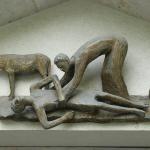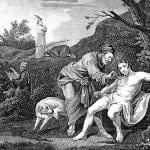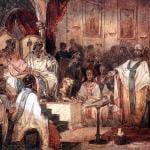THE SUNFLOWER AND THE ASYMPTOTE: College paper, heavily abridged, on the assumptions behind Augustine’s proof of God.
…Augustine makes two kinds of arguments for God’s existence, related in their emphasis on a necessary connection between mutable things and an immutable thing. He speaks of God as the “eternal and immutable form which preserves these mutable things from being reduced to nothingness, and preserves them… with their distinct varieties of form… Nothing can ‘form’ itself, because nothing can give itself what it does not have.” So rather than a “first cause” argument, in which God starts everything by creation but might then simply wind it up and let it tick, Augustine presents a more active God, constantly preserving and forming all of creation. This God did not solely create life-in-general, but also dogs, for dogs could not be recognizably doggy without being held together by this form.
Using a similar idea in the moral realm, Augustine says that we naturally seek the good and try to turn towards it, as a heliotropic flower seeks the sun. In fact, we love this sun; Augustine equates “the soul ought to be turned from corruption and converted to incorruption” with “not corruption but incorruption ought to be loved.” Although we may willfully turn away from what we conceive as good, that is an unnatural action; Augustine has nothing to say here to the immoralist or the debauchee. The particular ideas of good whic we use to try to fill the category “good” may differ, but for Augustine just the search for something to fill that category is a sign of a mutable being, with mutable reason, reaching toward an immutable God. …
…This may be a sidestep, from absolute truth swiftly to a God whom he talks about in very Christian terms; in the end he seems to be attempting a proof of a truth greater than ourselves, which by virtue of its perfection is somehow able to shape the world, and which acts as our standard for truth and goodness although we often use a highly distorted version of that standard.
The question of the asymptote arises. Because a curve appears to reach endlessly for a line, must we believe that the line is really there and the curve can touch it? In mathematics, as in theology, we speak of the asymptote reaching for infinity; but for some mathematicians infinity is a useful construct rather than a real property existing outside of the structure of our mathematical theories. Augustine implicitly believes that if almost everyone in the world is reaching toward a particular category–if we all choose certain ways to speak about what it is we want from the world and ourselves–then there must be some real truth there which we are glimpsing. This is his “public property,” available to all, and sought by all. It seems that if almost everyone is reaching for some ideal truth, believing that it is graspable, either that truth is real outside of us or we constructed it, as the mathematicians may speak of infinity. It seems we could not have stitched together the idea of the good the way one might stitch a “griffin” out of a crow and a cat, because the materials are not to hand; what can be used to construct an idea of the good? Perhaps by stitching together “unity,” “justice,” “mercy” we could arrive at such a monster; but we only know to pick those concepts because we generally recognize them already to be good.
[There’s quite a bit more, but that’s the part I like best. Here’s CS Lewis with an acute point, as well.]











